Mauna Kea is one of the must see spots on Hawaii and for people who love mountains and astronomy, it’s one of the top sites in the world. It’s also a sacred place to some natives and rich in ancestral history.
Visiting Mauna Kea isn’t as easy as just showing up to the access road, though.
Instead, you’re going to want to plan ahead to make sure that you’ll be allowed up on the summit so that you can catch a spectacular sunrise or sunset. And don’t forget about stargazing.
In this guide, I’ll tell you everything you need to know about visiting Mauna Kea.
Table of Contents
Overview of Mauna Kea
Let’s start off with some basic info to help you get an overall feel for Mauna Kea.
Mauna Kea is one of the four active volcanoes on the Big Island. It last erupted about about 4,500 years ago and it is believed that the volcano will erupt again.
Two common ways to experience Mauna Kea include: 1) going to the visitor center below the summit and 2) venturing up to the summit.
The Maunakea Visitor Information Station (VIS) sits at about 9,300 feet elevation and is located about 1 hour and 10 minutes from Kailua-Kona and about 45 minutes from Hilo.
The summit of Mauna Kea rises to 13,803 feet and it takes about 30 minutes to get from the visitor center up to the summit.
There are about a dozen observatories up on the summit including the famous Keck Observatory, home to the 3rd and 4th largest telescopes in the world! (In case you’re not aware, Mauna Kea is arguably the best place in the world for astronomy.)
Being the tallest point in Hawaii, Mauna Kea is considered sacred by some native Hawaiians as it holds lots of ancestral significance and ties to their stories of creation.
The construction of telescopes on top of the mountain has been a source of conflict, so it’s good to remember that and to always be respectful.
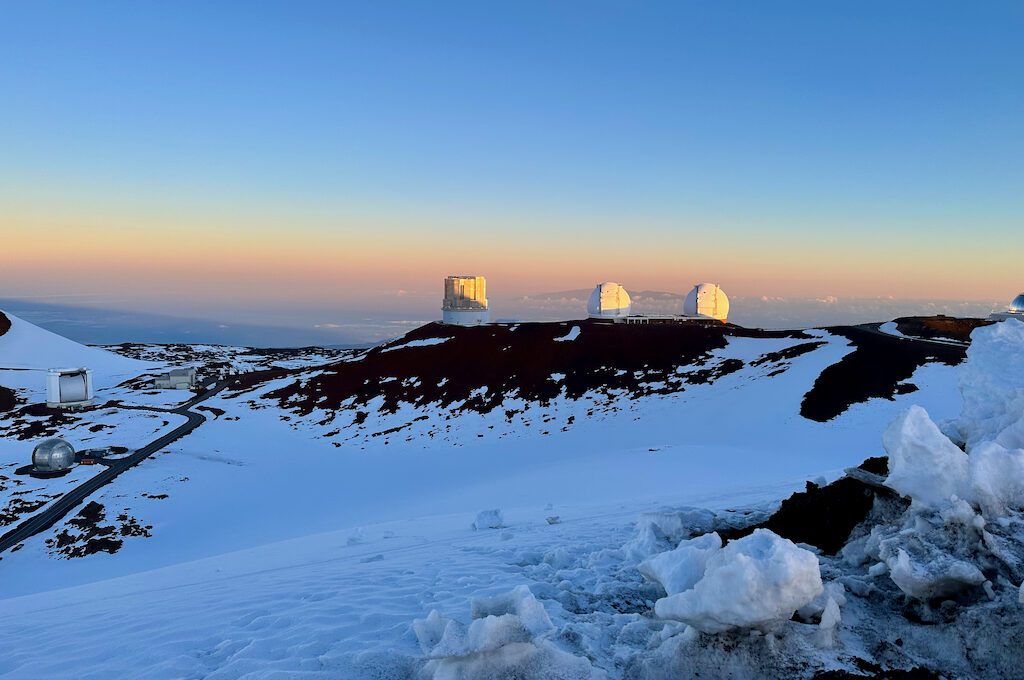
Things you need to know about visiting Mauna Kea
Here are a few things you want to know before heading up to Mauna Kea.
Give yourself time to acclimate
The Mauna Kea staff recommends that you spend at least 30 minutes at the visitor center acclimating — even better if you can spend one hour.
In an ideal situation, you would be able to spend a day or two acclimating. For example, if you were climbing in the Rocky Mountains you could stay in a mountain town for a night or two so that you’re going from something like 8,000 feet to 14,000+ feet.
But on the Big Island, there is a chance you will be going from sea level all the way up to nearly 14,000 feet which is a heck of a swing in elevation!
So you definitely want to do all that you can to acclimate which would mean spending some time at the visitor center. You’ll also want to stay well hydrated the day of your trip.
If you start to experience symptoms of altitude sickness, you’ll want to come down ASAP.
These symptoms include:
- Headache
- Feeling and being sick
- Dizziness
- Tiredness
- Loss of appetite
- Shortness of breath
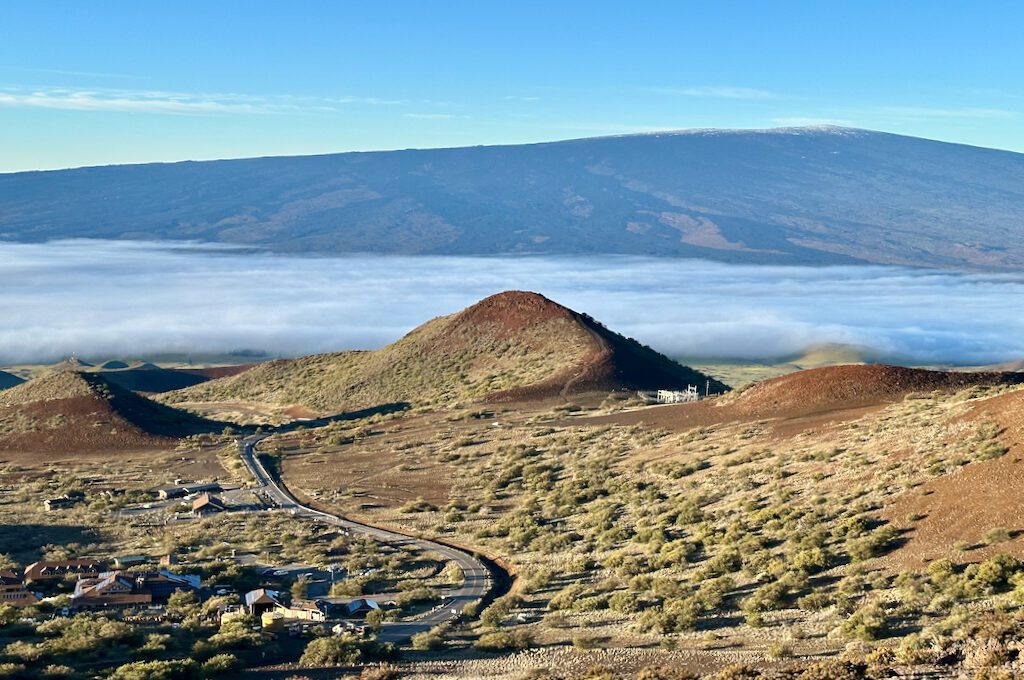
Weather and what to wear
Mountain roads are always a little bit suspect because they can often get shut down temporarily for various reasons including maintenance, accidents, and of course the weather.
On occasion, there could be a lot of snow or ice on top of the mountain.
If it’s very recent then the rangers may feel that the road is unsafe for the public and close it down.
Also, sometimes the wind can get crazy up there and unsafe so the rangers could also shut it down for that reason. This is why it’s a good idea to check out the latest road conditions and weather conditions.
And remember that at high altitude, weather conditions can change extremely quickly. It’s not uncommon for forecast to be inaccurate at such a high elevation so it’s good to be ready for all sorts of conditions.
As a rule of thumb, temperatures usually drop about 3° F for every 1,000 feet. So with the mountain being almost 14,000 feet, the temperatures up there could be somewhere around 40° to 45° F colder than at sea level!
Having a gaiter or some type of face mask to cover your face from the wind along with a solid puffer jacket and beanie, is a great way to be prepared for even the coldest conditions. Even in summer, the lows can be in the 30s!
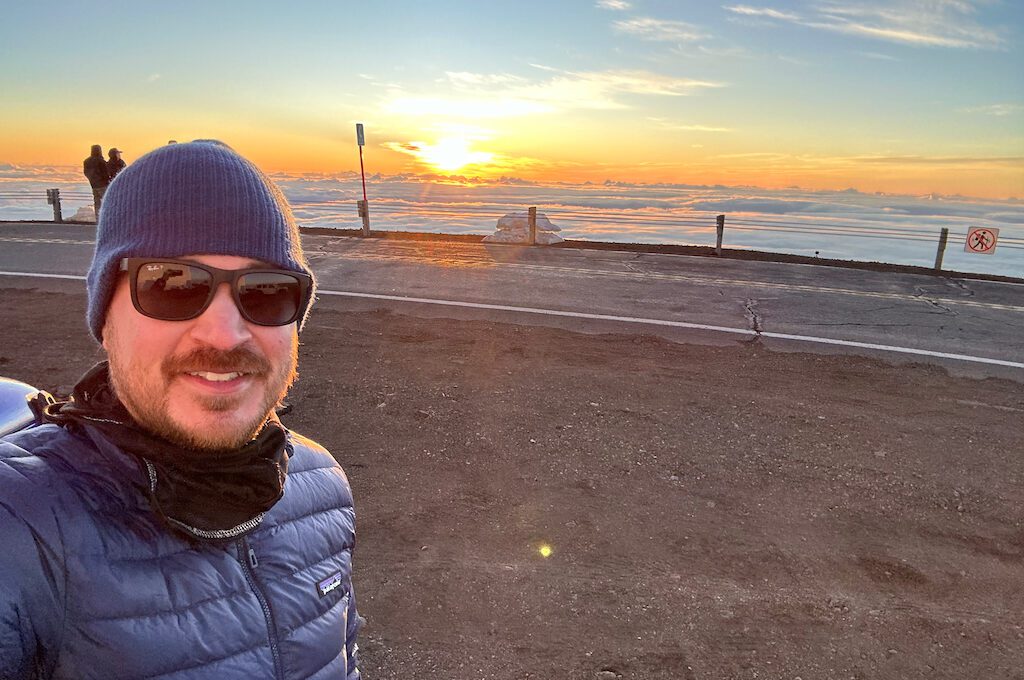
Tip: Call the visitor center before heading out to ask about the latest conditions and confirm everything is open.
If you want to see snow on top of Mauna Kea you can probably see that all the way into the summer or at least traces of it. We visited during late March and there was plenty of snow. I was actually really surprised at how thick the snow pack was and it was pretty cool to touch “Hawaiian snow.”
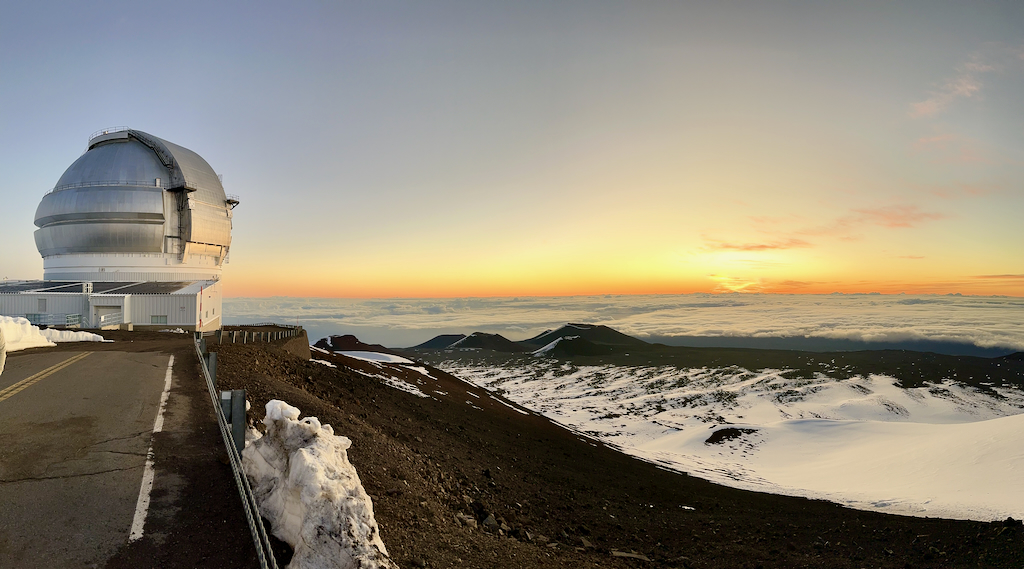
Get your vehicle ready and in order
Officials require you to take a four wheel drive vehicle to get up to the top.
A ranger will likely check to make sure that you have four-wheel-drive and that you know how to operate it because they want you to drive in four low (4L) going up and coming down. They also requested us to put it in manual on the way down and to keep it in second or third gear.
The ranger will probably go over the safety techniques for utilizing your brakes so that they don’t get cooked and you don’t find yourself in danger.
But in a nutshell, you basically just don’t use your brakes except for very few instances (e.g., around turns).
Whenever you come down they will do a brake check and check out the temperature of your brakes to see if you have been applying them too much.
If your brakes are too hot, I’m guessing that they will ask you to pull aside and wait but the ranger gave us a thumbs up after checking our temp so we are good to go.
Make sure that your vehicle is not low on gas and that you have at least half a tank of fuel because the last thing you want to do is get stuck up there.
They also want your vehicle to be clean (not bringing up a bunch of mud caked on the tires). This is because you could be bringing invasive plants up to the top which can affect the ecosystem.
And finally, if you are taking a rental vehicle up to the top make sure that you have permission. Not every rental car company will allow you to head up to the top.
Health status
They recommend not bringing children 13 years old and younger because they tend to have issues at high elevation.
I don’t think this is a hard rule and if you have a kid that has had no problem at high elevations (e.g., has hiked a 14er) then you may be able to explain that to the ranger and they could let you through.
But they also recommend not going up there if you have a pacemaker, cardiac or respiratory issues, or are pregnant.
And if you have been scuba diving in the past 24 hours, they advise you to not go up to the top.
In fact, I don’t even think that if you have scuba dived recently that you should even be driving on the saddle road since the elevation hits over 6,000 feet.
On our visit, we did the amazing manta ray night dive which meant that we had to push Mauna Kea out a couple of days to make it work. So plan accordingly!
Drones
Mauna Kea is a no-fly zone so drones are not permitted at the visitor center or at the summit.
There was a group of young people (wow, I sound old) out with a drone when we visited for sunrise and they kept flying it almost the whole time.
Not only was this against the no-drone policy but it also was a highly annoying to listen to while trying to appreciate the beauty of a serene sunrise. Drones flying overhead could also affect readings for the telescopes I’d guess. So please don’t be inconsiderate like these people.
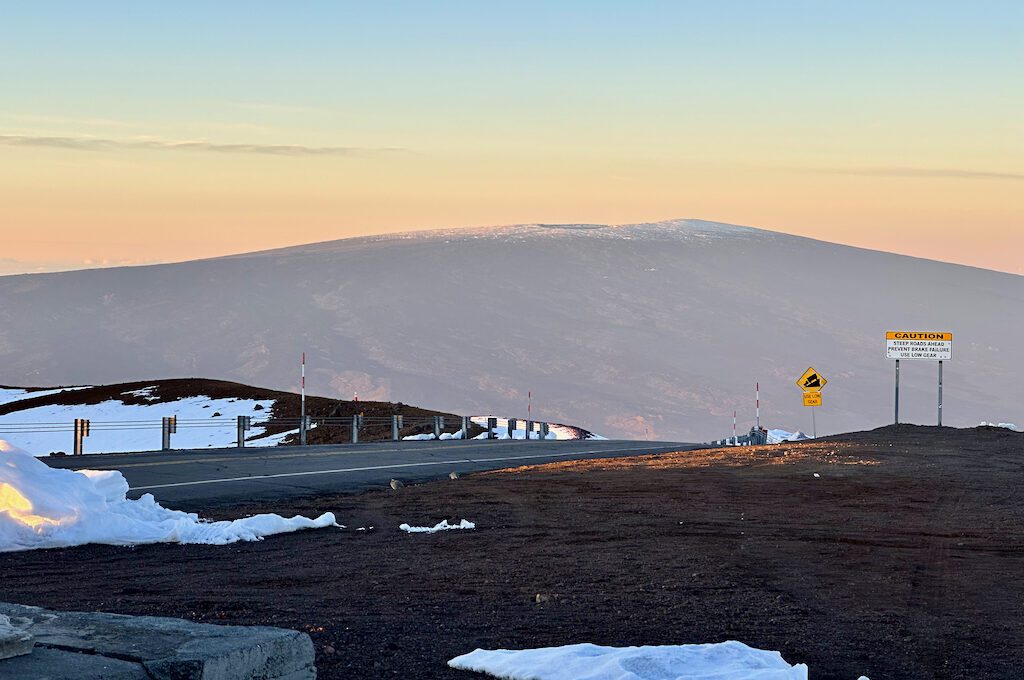
Toilets
There are some portable toilets near the summit so if you need to go you don’t have to come all the way down.
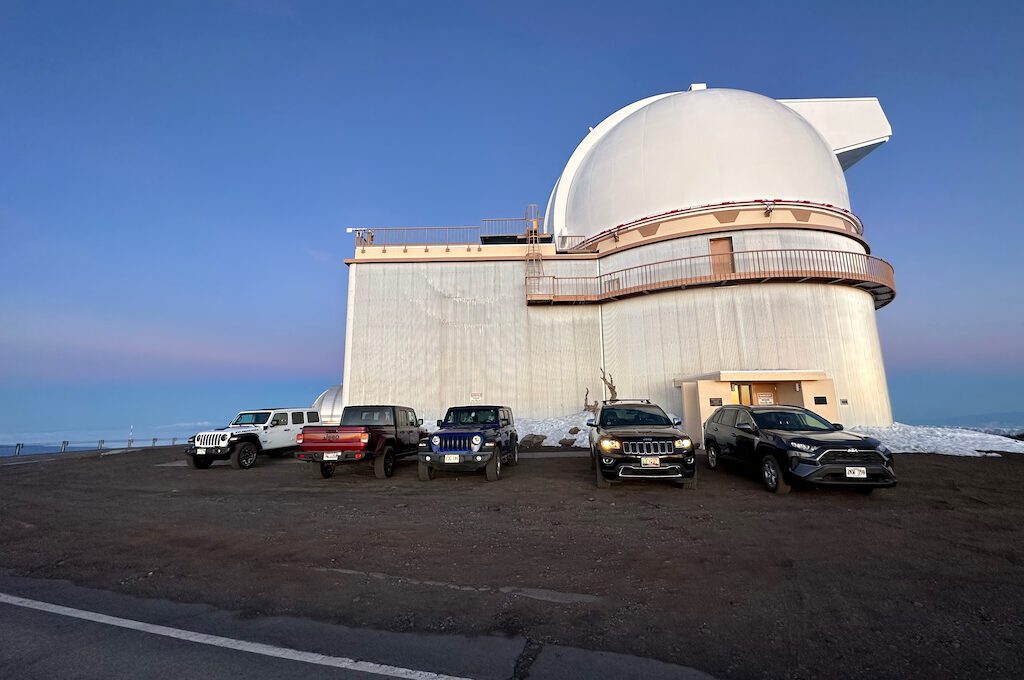
What is the road to the summit like?
The access road up to the Mauna Kea summit is paved in some parts and then a dirt road in other parts.
It’s a pretty wide road and while there are not rails on all places, it never felt like a “scary” mountain road to me. Don’t get too comfortable on the road but it just wasn’t that bad to me.
Also, I usually take some kind of motion sickness supplement before heading up on a mountain road but I did not do that for this one. Aside from some switch backs in the beginning, the road is not your typical endless winding mountain road.
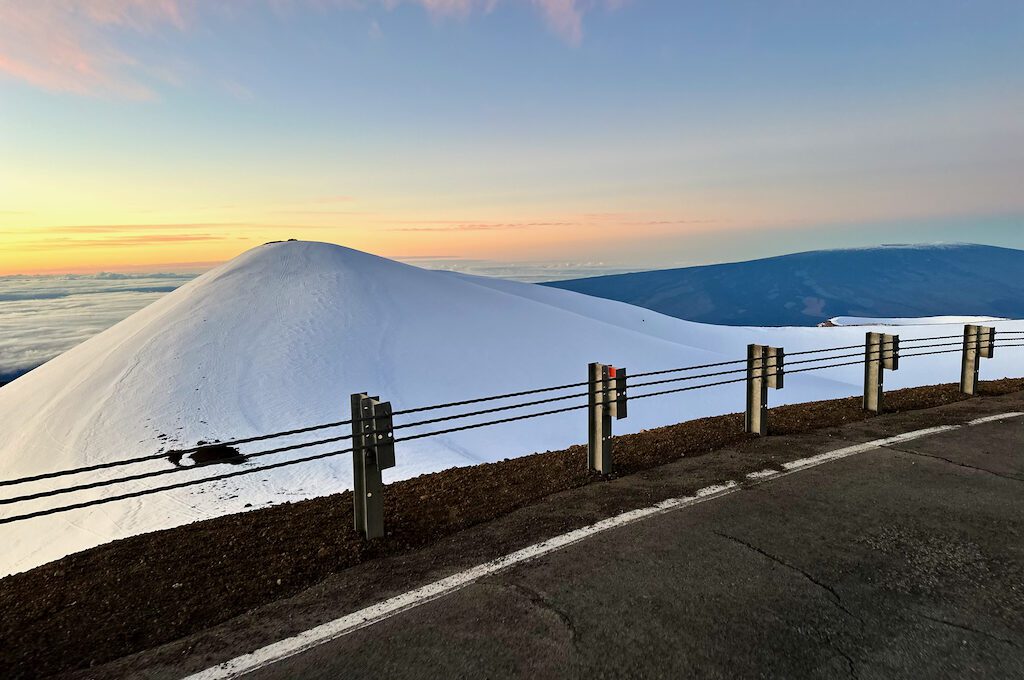
Visiting Mauna Kea for sunrise
We chose to visit Mauna Kea for the sunrise and it was a spectacular decision.
First, we arrived at the visitor center about two hours prior to sunrise. This was late March which meant we arrived about 4:20 AM. (Remember, the actual sunrise time will be a couple of minutes earlier at such a high elevation.)
There was only one other vehicle in the parking lot and so we decided to set up there but cars were coming in every few minutes.
At this time, the moon had already set and so the skies were super dark and the Milky Way had risen over the eastern horizon in spectacular fashion.
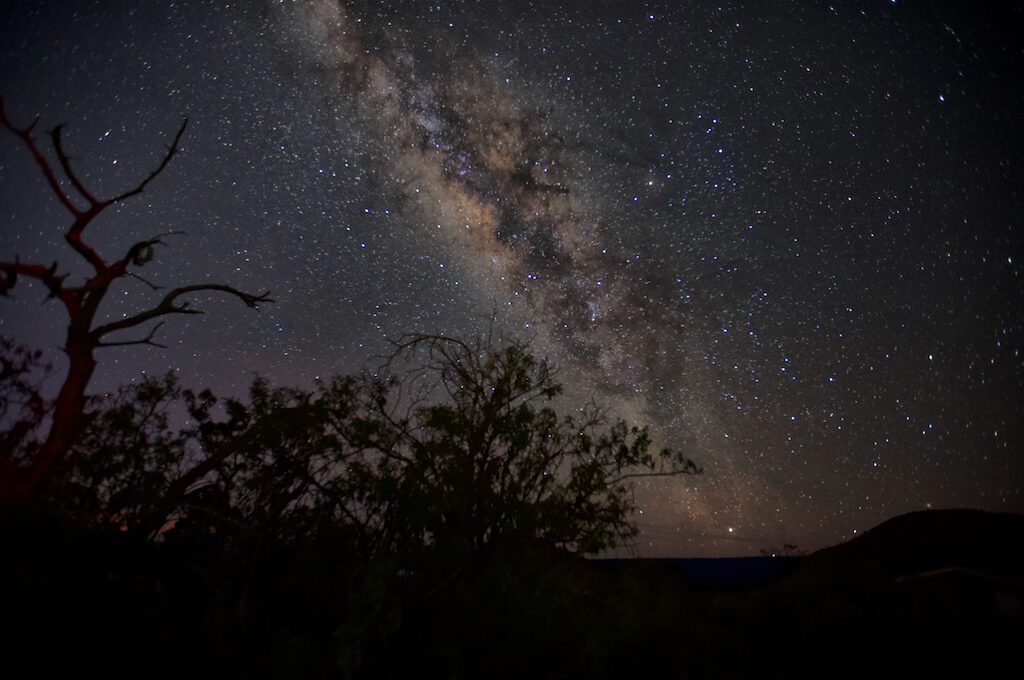
We allowed our eyes to adjust while getting some photographs of the Milky Way.
The challenge with getting astrophotography shots at the Mauna Kea visitor center is that there is a fair amount of vehicle traffic going in and out. This means that you have headlights or brake lights affecting your photos with lots of stray light.
It might be a good idea to venture down one of the trails to get away from the parking lot although it’s really hard to completely remove the possibility of headlights getting in your shots with long exposures unless you are completely isolated.
About 50 minutes before the scheduled sunrise time we made our way up to the summit but first we had to get through the ranger station, which involved checking in and getting a safety brief about all of the different factors mentioned above.
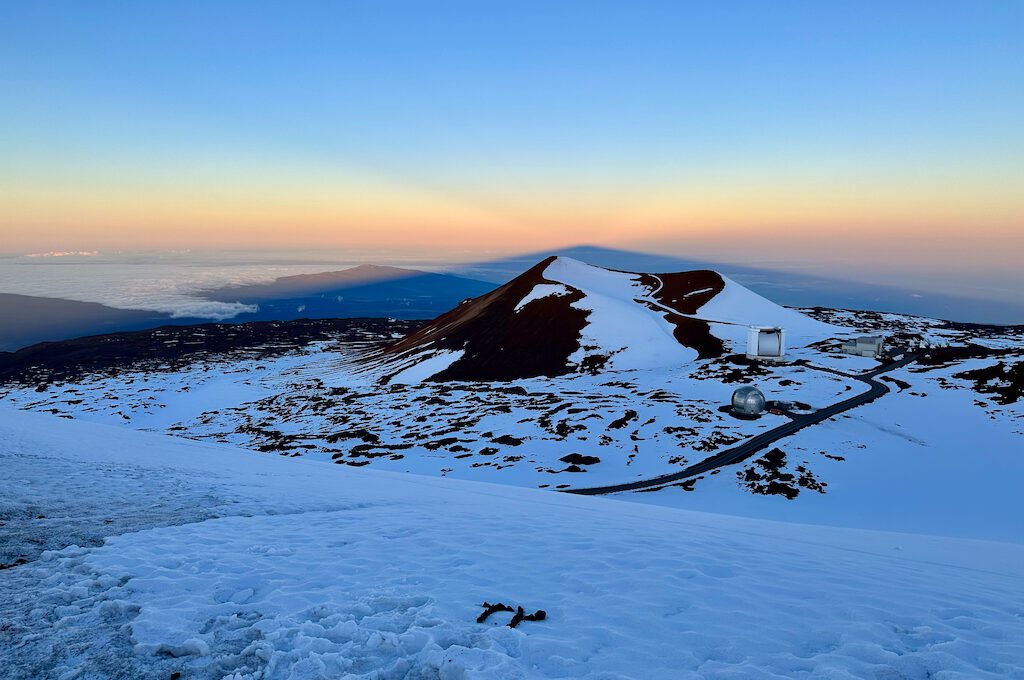
Visiting Mauna Kea for sunset
Visiting Mauna Kea during sunset is going to be the most popular time which means you’ll be facing more crowds.
Even when things are pretty busy, you still should be able to find a parking spot on top of the mountain as it’s usually only during the holidays that things get really crazy up there.
You’ll probably want to arrive on the summit at least 30 minutes prior to the sun setting. Keep in mind that they will close the access road about 30 minutes prior to sunset.
Because you need at least 30 minutes to acclimate, this means arriving at the visitor center at least one hour prior to sunset. Personally, I would try to arrive about 1.5 hours before sunset.
Just like the sunrise is a little bit earlier, the sunset will be a couple of minutes later than the stated time so keep that in mind. (It’s estimated that you add or subtract one minute for every ~5,000 feet of elevation)
To pass time, you can spend time checking out the visitor center or wandering around on one of the trails.
Just remember that the visitor center is also pretty high altitude (9,300 feet) so you may not want to do too much wandering if you are not used to high elevation sites.
Also, while you may be tempted to get up to the summit extra early, if you are prone to altitude sickness then spending less time up there is better so don’t leave the visitor center too early.
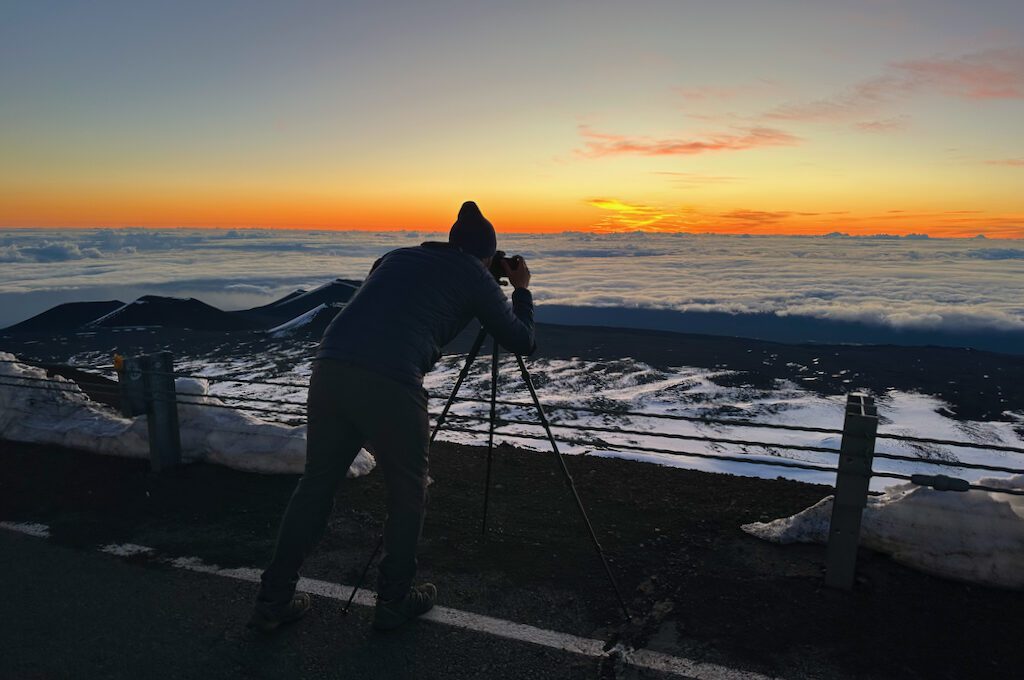
Mauna Kea Stargazing
In a perfect world, you could drive up to the top of Mauna Kea at any hour, sit down with a telescope, and admire the heavens for hours.
However, that’s not quite how it works.
First, because the summit is nearly 14,000 feet, your eyes will not be receiving as much oxygen as they would at a lower elevation.
This means that you won’t be able to observe the dim and faint objects as well as you could at a lower elevation such as at the visitor center. So you wouldn’t necessarily want to set up with a telescope on the summit.
Also, a lot of the telescopes on the summit are not your typical refractor or reflector telescopes. They rely on a lot of imaging and computers.
In the past, you could book a tour of the observatories to check them out but that is not currently offered.
However, there are still options for stargazing at Mauna Kea.
Typically, a stargazing tour will take you up to the top of the summit for sunset and after admiring the sunset you come back down to the visitor center and that is where the stargazing will take place.
You can schedule a free stargazing experience with the University of Hawaii but as of March 2023, they only offer these like once a month and you have to make reservations.
You can also book tours that will take care of your transportation, provide you with snacks, and give you some telescope time.
Another option could be to hope for astronomers to be set up at the visitor center. It’s possible that they could welcome you to use their scope to admire the sky.
This is one of the major drawbacks of going for a sunrise visit because the visitor center will not be open and chances are you won’t be able to secure a stargazing tour.
However, if you have your own gear or just want to get astrophotography shots then sunrise can be a good time to visit.
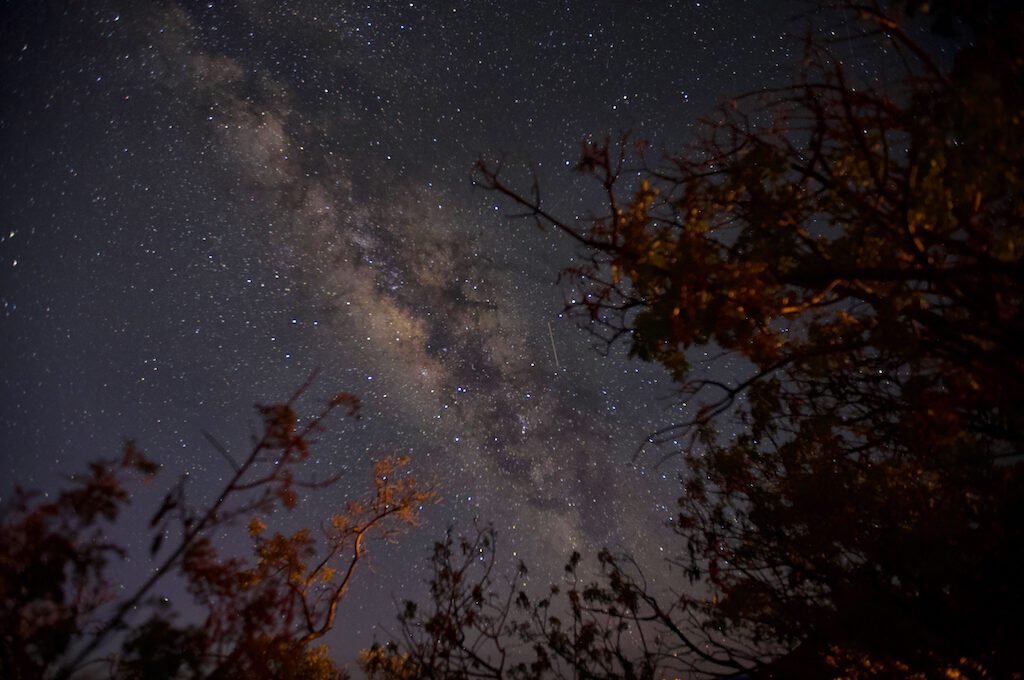
Hiking on Mauna Kea
I hate to break it to you but whenever you drive up to the “summit” of Mauna Kea, you actually are not on the summit.
However, from the summit parking area you can access the 1 mile Hawaii Highpoint Trail that will take you to the top of the summit. The elevation gain is only about 260 feet so this would normally be an easy hike but because of the elevation, it becomes more of a challenge.
Make sure that you are physically prepared to take on this hike and if you are already struggling with the high altitude, it may be better to pass on the hike.
We visited when the summit was covered in snow/ice and so we did not attempt the hike because we didn’t have any crampons which may have been needed.
For avid hikers, you also have the option of hiking up to the summit from the visitor center via the Mauna Kea-Humu’ula Trail. This is a major hike with nearly 5,000 feet of elevation gain and 13.5 miles round-trip.
Based on hike reports, it doesn’t appear that the trail is very steep which makes the hike a lot more doable but still I would not attempt this hike unless you have some real hiking experience and understand how your abilities hold up at high elevations.
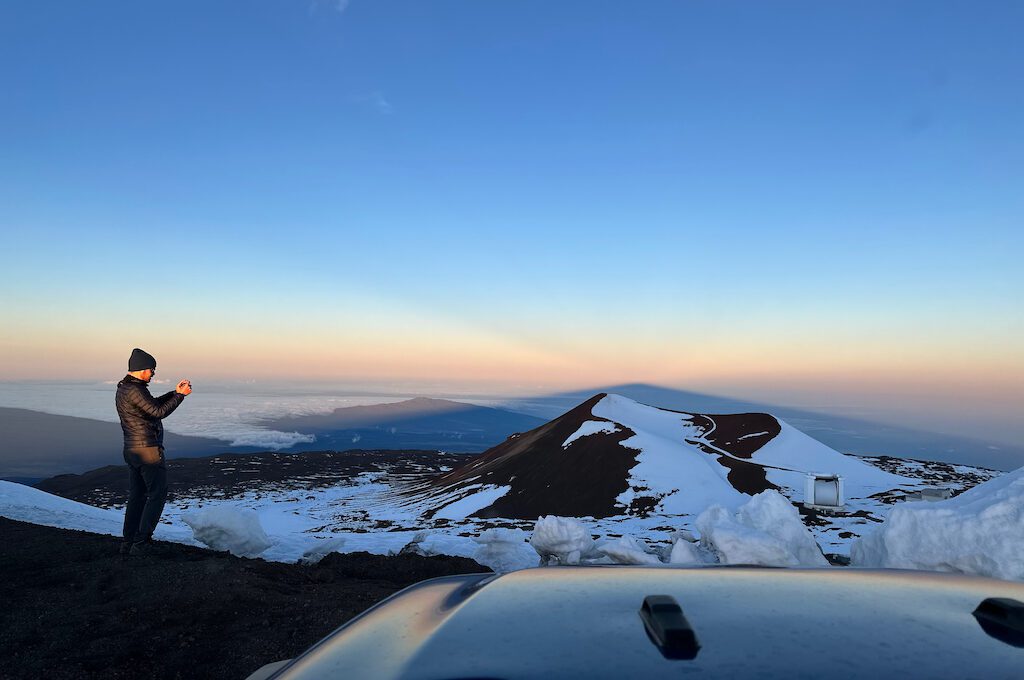
Final word
I loved visiting Mauna Kea for sunrise and seeing the brilliant Milky Way at the visitor’s center. But I also can’t wait to get back to check out at sunset and perhaps book a stargazing tour as well as make my way to the top of the summit.
I’d say that it’s definitely worth visiting Mauna Kea but that you need to make sure you are well prepared because of all of the requirements and challenges with heading from sea level to around 14,000 feet.
Daniel Gillaspia is the Founder of UponArriving.com and the credit card app, WalletFlo. He is a former attorney turned travel expert covering destinations along with TSA, airline, and hotel policies. Since 2014, his content has been featured in publications such as National Geographic, Smithsonian Magazine, and CNBC. Read my bio.

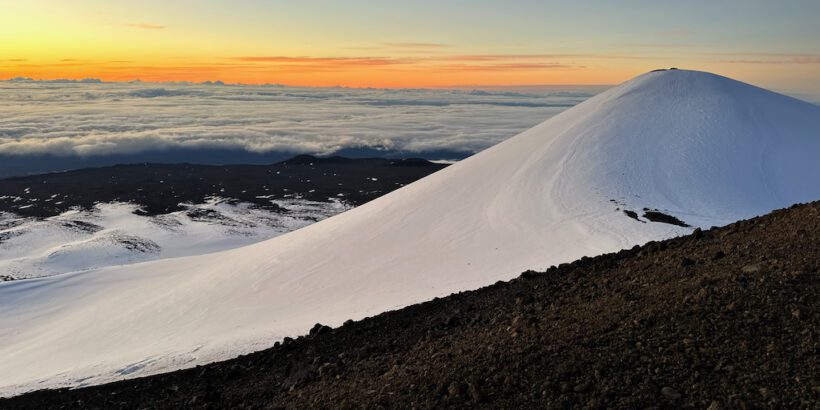
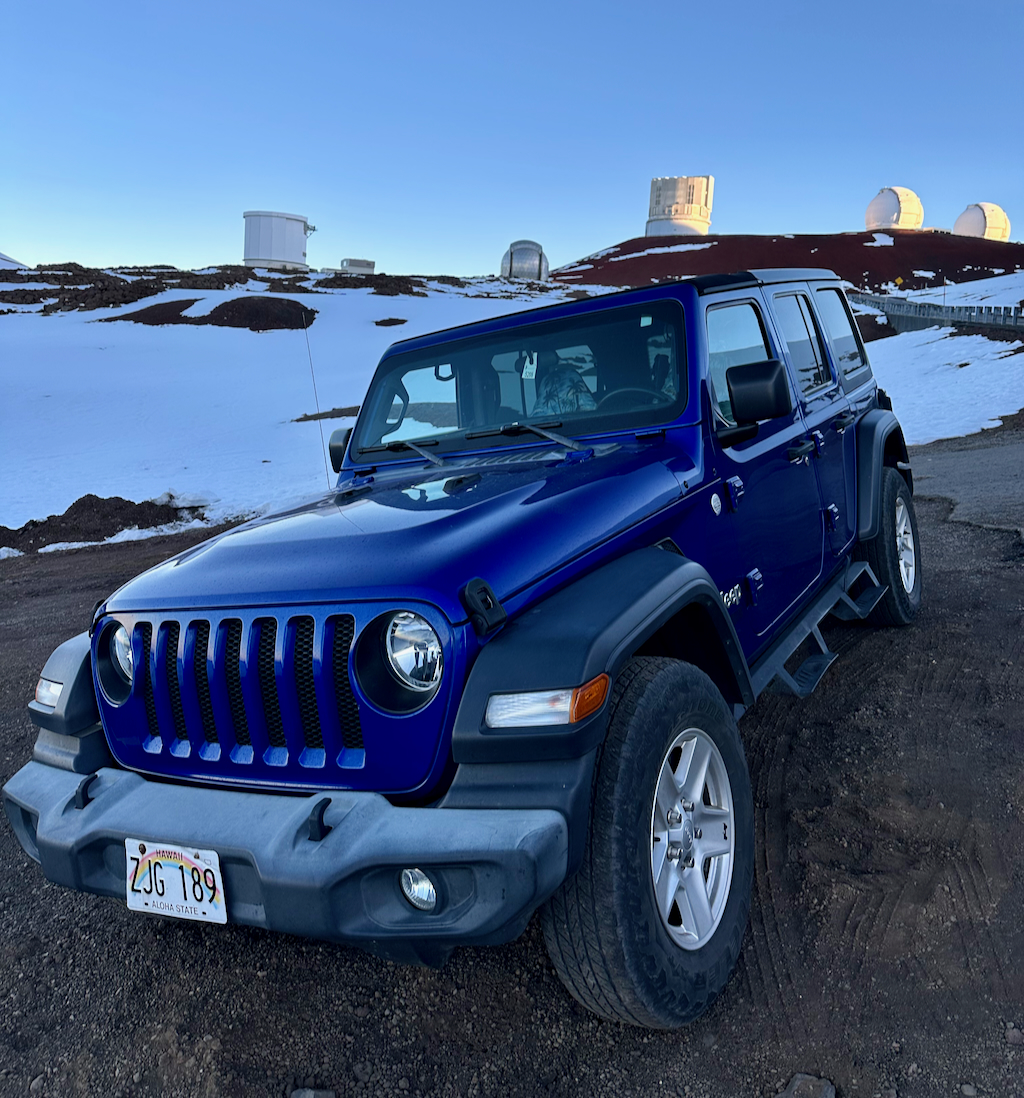
It is nice place to visit. well done!
pretty cool!
that’s one of my Jeeps in the photo. corp rental agencies don’t let you go up the mauna but we do at Big Island Jeep rental.
https://www.bigislandjeeprental.com/maunakea
aloha!
-Joe
You mention those 13 and younger, as well as those with heart issues, pacemaker, pregnant, etc. shouldn’t visit due to safety. Can they still enjoy the visitor center and not go up the summit? Or is the visitor center even as issue for this group of people? If yes to the visitor center, is it even worth it? (are there still good views?)
Thanks!